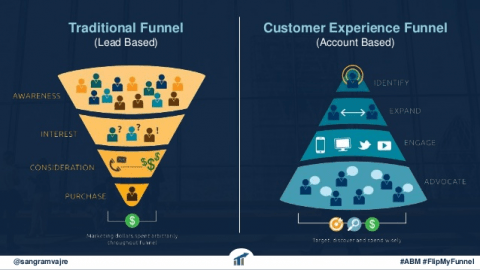At the dawn of the age of B2B digital marketing, it was all about the ‘shotgun approach’: focus on conversion rate, volume of traffic and try to bring in as many leads as humanly possible. However, as digital marketing has transformed, allowing detailed targeting – along with a skyrocket in consumer expectations around personalisation – it’s crucial for B2B marketers to move with the times.
When it comes to account-based marketing (ABM), the co-founder of Terminus, Sangram Vajre, uses the phrase ‘fishing with nets’ for lead generation throughout his ABM presentations. This phraseology is the simplest and most accurate way of differentiating ABM from standard lead generation.
Inbound marketing is all about fishing with nets, capturing as many leads as possible. ABM changes this approach and swaps the net out for a spear.
So, what is account-based marketing?
Account-based marketing is a marketing approach that focuses on a specific set of targeted predefined accounts, creating personalised experiences for those accounts to generate highly-qualified leads. Account-based marketing forces close alignment between sales and marketing teams. This is because successful ABM requires an understanding of the motivations, frustrations and needs of the individual accounts.
Using Sangram Vajre’s metaphor, ABM forces ‘fishing with spears’: you are no longer concerned with bringing in as many leads as possible. Instead, the switch of focus means that sales have a critical purpose in marketing efforts by identifying a set of accounts that are aligned with the business, and then working closely with marketing to create truly customised journeys, specific content and individualised messaging for these accounts.
This goes against the ‘shotgun’ approach that blanket campaigns can result in. According to the ITSMA (the Information Technology Services Marketing Association) definition from their 2019 benchmark study, Moving to ABM Maturity, ABM treats “accounts as markets in their own right” and focuses marketing efforts in this same way.
Let’s break this down to a real sales situation. We all know from experience that when a sales decision is being made, there are usually many different stakeholders involved that typically fall into a ‘researcher’ and ‘decision-maker’ model. The larger the company, the more people involved in the decision itself, and there are many more people that need to be satisfied before a deal can be made. ABM takes this into consideration and doesn’t focus on the individual, but focuses on the businesses instead and seeks to satisfy each of the decision-makers within a company – or, in ABM speak, account.
Account-based marketing turns the traditional inbound marketing funnel upside down:

Why would you want to practice ABM?
If you’re wondering why you should practice ABM, the best place to start is looking into Pareto Principle (or the 80/20 rule). ABM forces you to plan, identify and really think about a personalised experience for the accounts that have been identified – specifically, the ones your business wants to work with. Effectively, you are spending 80% of your time in the right areas. It also forces you to consider the viewpoints of individuals within a business and make sure that you are attempting to influence all the key stakeholders.
We are also living in a world of very high expectations: no longer can large-scale, generic e-shots be used to gain leads. Potential customers expect personalised and tailored marketing, and they also expect effort. Solving an individual’s problems has to be your focus, engaging with them on a personal level and then influencing them – it’s worth mentioning that, now, over two-thirds of a B2B buying committee has a millennial on it and that 30% of millennials are now senior decision-makers in a company.
Just as Megan Golden explains in her LinkedIn article ‘What Is Account Based Marketing, Why You Should Adopt It, And How’:
“A personalised approach is essential when aiming marketing and sales efforts at a few select, high-value accounts. Personalise well and buyers are more open to your outreach and less likely to ignore your content and communications.”
Megan Golden
The top three benefits of account-based marketing
Everyone loves a ‘top 3’ and here are our top 3 points as to why you should implement account-based marketing in your business.
1) A more focused sales and marketing funnel
Because ABM is so targeted with its marketing efforts, resource waste is limited. As Joe Chernov said: “ABM aspires to be ‘zero-waste’ marketing.”
Cross-team collaboration and improved communication will always going to be hugely beneficial to any business but, when it comes to ABM, this ensures that your sales and marketing teams are focused on the same objectives, with a clear view of who you’re going after – and why.
2) Better customer experiences
Instead of going for a shotgun approach and showcasing huge amounts of broad content that is ultimately generic and certainly not personalised, with ABM you go deep — researching accounts and designing campaigns specifically for them.
Usually, we would see content that is focused around a subject area, market or industry. Account-based marketing really gets us thinking about content and information that is important and interesting to the individual account – that content only gets shown to that individual account or group of accounts.
Combine this narrow, personalised focus with an amazing customer experience and conversion rates will soon start to climb.
3) ROI and Effectiveness of Time Spent
LinkedIn and ITSMA’s benchmark survey found that 84% of businesses who use ABM reported an increased ROI.
Remember, ABM is fishing with a spear, not a net. This means that there’s considerably less “by-catch” as you’re only engaging with prospects that are likely to buy and accounts that you have identified and actually want. Not sure if ABM is for your business? Start small: if the ROI you measure on your initial ‘test’ campaign proves that your ABM tactics have gained traction, you can use this intel to drive your marketing forward.
So what makes ABM so very different?
You may feel like what you are doing right now is quite similar to ABM. You may feel like your digital team is being ultra-targeted with their activity and you may be happy with all the high-quality leads you are getting at the moment. However, ABM is the next level of B2B marketing.
1. ABM marketing is beyond the targeting that you are doing right now
You may be already using all the targeting methods that networks and channels allow you to use (location, job titles, industries, etc.), but ABM goes well beyond that. ABM targets the exact companies that you want to work with, the ones that are most likely to buy from you and using the very similar channels, just with a very different approach.
2. ABM marketing focuses on accounts and needs time to truly understand these accounts.
The best marketing and sales teams who undertake ABM successfully truly know their targeted accounts. Why? Because ABM forces practitioners to be personalised and to produce content that is interesting and engaging to predefined accounts.
3. ABM marketing isn’t just about getting more brand new customers
It isn’t just there to bring in brand new accounts; it also focuses on the accounts that you already have and increases the growth of these current accounts. In some ways, ABM might be more aligned to work that your client services or internal sales/existing business teams are already doing.
The role of marketing in account-based marketing
But ABM isn’t just a ‘sales department problem’ – marketing plays a fundamental and crucial role in ABM. The most critical aspects are really around the ideation of the user journey, making the user-journey personalised to individual accounts and truly creating great content that leads to a conversion.
Channel marketing is just as critical once all the planning and creation has been completed. The user journey needs ‘users’ and the only way this happens is through fantastic use of digital marketing. Choice of channels, targeting, amplification and a sequential journey through a personalised experience is how digital marketing makes account based marketing a success.
The role of sales in account-based marketing
The very first part of this article talked about the identification of a set of accounts and this should come from your sales team. Your sales team has the in-depth knowledge of current customers and customers they would love to work with. They engage with these companies daily, understand their challenges, issues and requirements: your sales team really are a great starting point when it comes to ABM. In fact, Forrester research found that organisations with aligned sales and marketing teams see an average of 32% annual revenue growth while less aligned companies reported an average 7 percent decline in revenue.
The best resources to understand more about account-based marketing
Here’s some further reading on account-based marketing:
- LinkedIn marketing solutions blog: What Is Account Based Marketing, Why You Should Adopt It, And How
- Drift: Account-Based Marketing
- LinkedIn business solutions: I heart ABM: Bringing sales and marketing together (see video above)
Have you just learned something new?
Then join the 80,000 people who read our expert articles every month.









